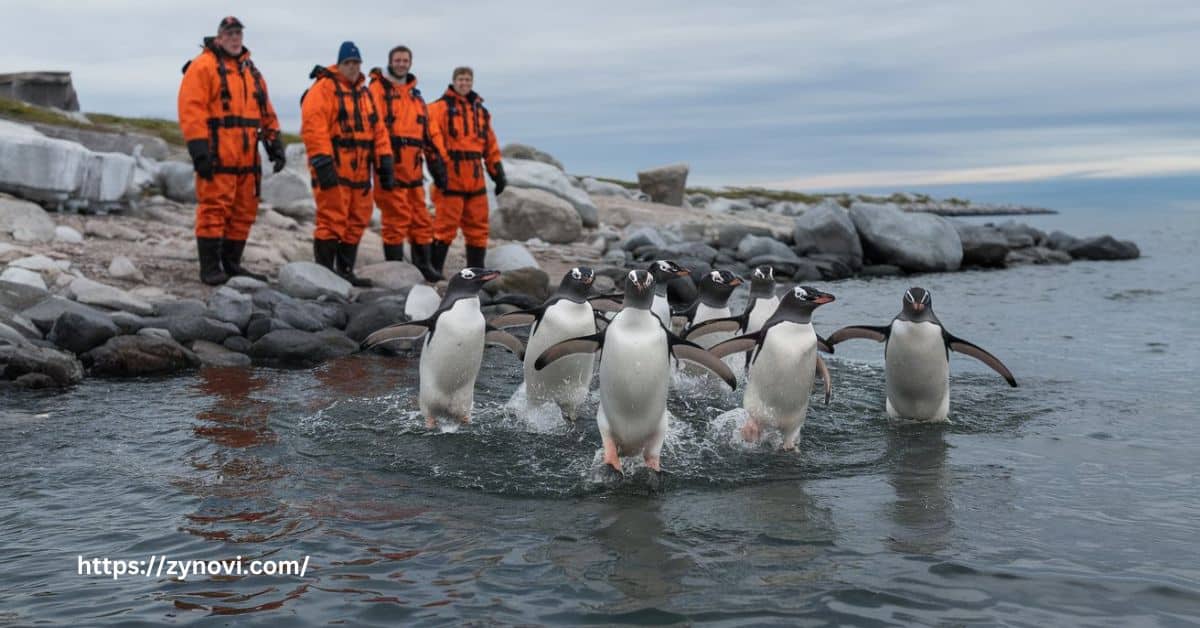Do penguins attack humans? Penguins rarely attack humans, but they may defend themselves by pecking, flapping, or charging if they feel threatened.
It’s a question that many curious nature lovers and animal enthusiasts wonder about, especially when they encounter these charming, tuxedo-clad birds in the wild. Penguins are often seen as cute and harmless, but like any wild animal, they can show a more defensive side when they feel threatened.
In this article, we’ll find the fascinating world of penguins, exploring their behavior, defense mechanisms, and how to interact with them safely. You’ll learn when penguins might get aggressive and how you can enjoy these remarkable creatures without putting yourself or them in danger. Keep reading to find out more!
Understanding Penguins
Penguins are one of the most beloved and recognizable birds in the world. Their black-and-white plumage, waddling gait, and charming antics make them a favorite among wildlife enthusiasts.
While these flightless birds are generally seen as harmless, there are instances of penguin aggression that might surprise you.
Overview of Penguin Species
There are 18 species of penguins, each with unique characteristics. Some of the most well-known include:
| Penguin Species | Habitat | Notable Traits |
|---|---|---|
| Emperor Penguin | Antarctica | Largest penguin species, social breeders |
| Adelie Penguin | Antarctica | Highly territorial, aggressive during nesting |
| Gentoo Penguin | Sub-Antarctic | Fastest underwater swimmers |
| Little Blue Penguin | Australia, New Zealand | Smallest species, nocturnal behavior |
| Galapagos Penguin | Galapagos Islands | Only penguin species near the equator |
Penguin Social Behavior
Penguins are highly social birds, thriving in large colonies that can number in the thousands. They rely on vocalizations, body language, and physical contact to communicate with each other.
Their social structure helps with breeding, hunting, and protection from predators. While many species, like the Emperor Penguin, exhibit friendly and curious behavior.
Others, such as the Adelie Penguin, are known for being territorial and aggressive, especially during the breeding season when they fiercely defend their nests.
Do Penguins Fear or Trust Humans?

Do Penguins Attack Humans? Unlike many wild animals, penguins in remote Antarctic regions have little to no natural fear of humans. This is largely because they have no land predators in these areas. However, in regions where human interaction is more frequent, they may exhibit caution or defensive behavior.
Do Penguins Attack Humans?
General Temperament of Penguins Around People
Penguins are naturally curious creatures and often show little fear of humans. In places like Antarctic research stations and wildlife tourism sites, they have been observed approaching people out of curiosity rather than aggression.
However, penguin aggression can occur, particularly if they feel threatened, cornered, or protective of their young and nesting sites. While most species remain docile, some, like the Adelie Penguin, may display territorial behavior and use pecking or flipper slaps as a defense mechanism.
Situations That May Trigger Aggression
While penguins are not typically aggressive toward humans, certain factors can provoke defensive behavior:
- Protecting eggs and chicks – During breeding season, penguins become highly territorial and will aggressively defend their nests.
- Feeling threatened or cornered – A penguin that feels trapped with no escape route may resort to pecking or flipper slaps.
- Food competition in captivity – Penguins in zoos or marine parks may exhibit aggressive pecking when competing for food.
- Human interference – Tourists and researchers who invade their space can provoke defensive reactions, including vocal warnings or lunging.
How Penguins Defend Themselves
Penguins have several defense mechanisms they use when threatened:
| Defense Mechanism | Description |
|---|---|
| Pecking with Beak | Penguins have sharp, hooked beaks that can deliver a painful bite. |
| Flipper Slaps | Their strong, muscular flippers can hit with surprising force. |
| Vocal Warnings | Loud squawking or braying serves as a warning sign. |
| Charging and Posturing | Penguins may puff up their chests and charge an intruder. |
Are Penguin Attacks Dangerous? Understanding the Risks

Strength of a Penguin’s Beak and Flippers
Penguins may look cute and harmless, but their beaks and flippers are surprisingly strong. Their sharp, curved beaks help them catch and tear apart fish, squid, and krill.
Species like the Emperor Penguin and Gentoo Penguin have particularly powerful beaks capable of puncturing tough fish skin, meaning a bite from one can cause painful scratches or minor injuries.
Additionally, their flippers, which they use for swift underwater movement, can deliver strong slaps when defending themselves.
Documented Cases of Penguin Aggression
While rare, there have been recorded incidents of penguins attacking humans under specific circumstances:
- Adelie Penguins attacking researchers: In Antarctica, researchers have reported being pecked and slapped when venturing too close to nests during breeding season. These penguins are known for their territorial nature and will defend their space aggressively.
- Gentoo Penguin aggression in captivity: Zookeepers and marine park handlers have observed flipper strikes and pecking when handling or feeding these birds. Competition for food and stress in captivity can make them more defensive and aggressive.
Comparing Penguins to Other Territorial Birds
Compared to other aggressive birds, penguins are less dangerous but still capable of defending themselves:
| Bird Species | Aggression Level | Common Defense Tactic |
|---|---|---|
| Penguins | Low to Moderate | Pecking, flipper slaps |
| Seagulls | High | Dive-bombing, pecking |
| Geese | High | Biting, hissing, wing flapping |
How to Avoid Aggressive Penguin Behavior

Responsible Wildlife Interaction Tips
When observing penguins in the wild, follow these essential wildlife interaction guidelines:
- Keep a safe distance (at least 5 meters/15 feet)
Maintain a respectful distance to avoid disturbing the penguins’ natural behavior and ensure their safety. Getting too close can cause stress and even force them to abandon their area. - Avoid making sudden movements that could startle them
Penguins are sensitive to sudden changes in their environment. Moving calmly and slowly allows them to remain undisturbed and not feel threatened. - Do not feed penguins, as it disrupts their natural hunting behavior
Feeding penguins alters their natural feeding habits and can make them dependent on human-provided food. This can impact their survival skills and long-term health. - Respect nesting sites, especially during the breeding season
Stay away from penguin nesting sites during breeding season to avoid disturbing their eggs or chicks. Your presence could cause unnecessary stress, potentially leading to abandonment of nests.
Signs a Penguin Feels Threatened
Penguins display clear body language when they feel uncomfortable:
- Loud squawking or braying
Penguins may make loud vocalizations to warn others or express distress when they feel threatened or cornered. - Ruffled feathers or puffed-up posture
A penguin may puff up its feathers to appear larger and more intimidating when it feels threatened. - Flapping flippers aggressively
Flapping their flippers can be a defensive action, signaling aggression or an attempt to ward off a perceived threat. - Direct eye contact followed by charging
If a penguin locks eyes with you and then charges, it’s a clear sign that it feels challenged or threatened and is preparing to defend itself.
Ethical Guidelines for Observing Penguins in the Wild
Here are the ethical guidelines for observing penguins in the wild:
- Visit wildlife reserves and research stations with established ethical guidelines
Choose locations that prioritize wildlife conservation and adhere to strict ethical practices to ensure minimal disruption to penguins’ natural habitats. - Refrain from touching penguins, even if they approach you
While penguins may appear curious, it’s important to avoid physical contact as it can stress them and alter their behavior. - Use zoom lenses for photography instead of getting too close
Capture the beauty of penguins from a distance using zoom lenses to prevent disturbing them or interfering with their natural activities. - Support conservation efforts to protect penguin habitats
Contribute to organizations and initiatives that focus on preserving penguin habitats and promoting sustainable environmental practices to safeguard their future.
Final Verdict
While penguins are not naturally aggressive, they do have defensive instincts and may react if they feel threatened or provoked. They can peck with their beaks, flap their strong flippers, or even charge at perceived threats, but these actions are usually meant as warnings rather than full attacks.
The risk of injury from a penguin is minimal, especially when observing them responsibly. However, respecting their space and following ethical wildlife interaction guidelines is crucial to ensuring both your safety and their well-being in their natural habitat.
FAQs
Are penguins friendly towards humans?
Penguins are generally curious and may approach humans, but they are still wild animals and should be observed from a distance.
What to do if a penguin approaches you?
Stay still, avoid sudden movements, and let the penguin explore on its own without touching or feeding it.
Are penguins harmful to humans?
Penguins are not dangerous, but they can peck or slap with their flippers if they feel threatened or cornered.
Are penguins ever aggressive?
Penguins are usually peaceful but may become aggressive if defending their territory, nest, or young.
Conclusion: Do Penguins Attack Humans?
While penguins are generally gentle and fascinating creatures, it’s important to recognize that they are not entirely defenseless. These birds have developed various ways to protect themselves from threats, such as aggressive flapping, loud vocalizations, and charging when they feel threatened.
By understanding their natural behaviors, defense mechanisms, and adhering to responsible wildlife interaction guidelines, humans can enjoy observing penguins without causing them distress. Respecting their space, not feeding them, and avoiding unnecessary contact ensures a safe and enjoyable experience for both humans and these remarkable, resilient birds.










